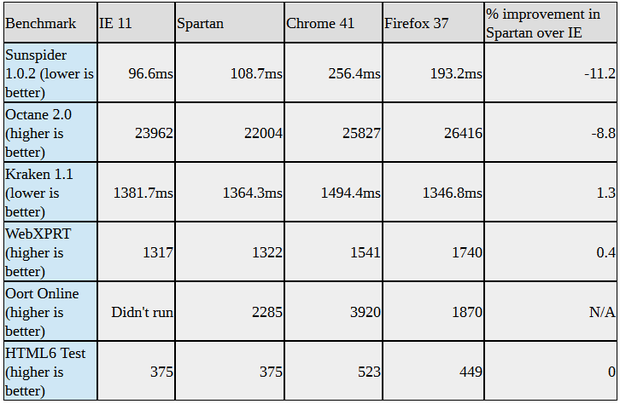How does Microsoft's new browser stack up against the competition?
After years of Internet Explorer losing market share to rivals, Microsoft is hoping to recapture lost ground with its new Spartan browser.
Microsoft's follow-up to Internet Explorer was available to the public for the first time this week as part of the Technical Preview of Windows 10.
The most noticeable difference from IE is the look of the browser. The interface has been designed to fade into the background, with icons appearing as light grey line art and tabs delineated by minimal lines.
Integrated into the browser is Microsoft's smart assistant Cortana. Users can type queries into the address bar and Cortana will attempt to answer them. Cortana can also add context to an article, if the user highlights text and clicks "Ask Cortana". However, these features currently only work for English speakers in the US.
Other additions to the toolbar include a Reading View, which strips away everything around the main article, as well as the ability to annotate web pages with notes and drawings.
An oft-repeated criticism of Internet Explorer was its failure to support web technologies that worked in other browsers, leading to complications in ensuring cross-browser compatibility. Microsoft wants Spartan to keep up with competing browsers in this regard, and to this end has shifted Spartan to the new Edge rendering engine. As well as being built around modern web standards, Edge should also allow Spartan to run more efficiently by jettisoning years of legacy code found in IE's Trident engine.
Microsoft stresses this is an early outing for Spartan, with more features to be added and other tweaks made. Consequently there are still some notable absences from the initial release, with both the downloads and history sections missing.
But how does Spartan's performance compare to that of its predecessor and rival browsers. We put the browser through its paces using a variety of benchmarks.

spartangraph.png

Tests were run on a clean install of Windows 10 Build 10049 on a Toshiba Portege laptop. The machine has an 2.1GHz Intel Core i7 4600U processor, with 8GB of memory and a 256GB SSD. As mentioned the browser is at an early stage in its lifecycle, so these results are subject to change.
Interestingly the results were markedly different to early tests of Spartan technology. When tech website Anandtech ran the same benchmarks earlier this year it found Spartan's Edge rendering engine returned demonstrably better results than IE's Trident engine. In contrast our benchmarks found Internet Explorer and Spartan to be almost neck and neck, with IE coming out on top in several tests.
Spartan uses the Chakra JavaScript engine used by Internet Explorer and Google's Octane JavaScript benchmark found the two Microsoft browsers returning similar performance, with Internet Explorer slightly edging it. However, Chrome and Firefox outstripped them both.
Spartan and IE were once again close in the Sunspider JavaScript benchmark but, in contrast to Octane, the Microsoft browsers returned significantly better scores than Chrome and Firefox. Again this was noticeably different to the Anandtech benchmarks, which found performance parity between Chrome and the Spartan rendering engine in Octane and Kraken.
WebXPRT is designed to see how the browser handles everyday tasks: testing how long it takes to apply effects to photos, to detect faces inside images, to display a stocks and shares dashboard and handle offline notes. These benchmarks measure performance in a range of rendering and JavaScript-based workloads. Both Chrome and Firefox proved more proficient that the Microsoft browsers, although both IE and Spartan handled the tests with almost equal aplomb.
When it came to 3D graphics, Spartan wasn't able to match the performance of Chrome when running the Oort Online game engine. Unfortunately the demo wouldn't run in Internet Explorer.
As for which browsers support the latest web technology, both IE and Spartan scored behind Firefox and and Chrome in the HTML6 Test, again reflecting the fact that there is still much to be added to Spartan.
While Spartan felt fast and responsive to use, on paper this initial release didn't demonstrate any significant performance gains over IE, although expectations should be tempered by the fact that it is so early in the browser's lifecycle. Perhaps the best is yet to come.

